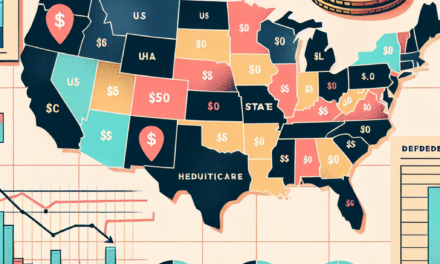Building Financial Resilience in Healthcare: A Comprehensive Guide
In an era marked by rapid technological advancements, shifting patient demographics, and evolving regulatory landscapes, the healthcare sector faces unprecedented financial challenges. Building financial resilience is not merely a strategic advantage; it is a necessity for healthcare organizations aiming to thrive in this complex environment. This comprehensive guide explores the multifaceted approach to enhancing financial resilience in healthcare, focusing on five critical subtopics: understanding financial resilience, strategic financial planning, revenue cycle management, cost containment strategies, and leveraging technology for financial health.
Understanding Financial Resilience in Healthcare
Financial resilience in healthcare refers to the ability of healthcare organizations to withstand economic pressures, adapt to changes, and recover from financial setbacks. This concept encompasses various dimensions, including liquidity, profitability, and operational efficiency. Understanding these dimensions is crucial for healthcare leaders aiming to build a robust financial foundation.
One of the primary indicators of financial resilience is liquidity, which measures an organization’s ability to meet short-term obligations. A healthcare organization with strong liquidity can navigate unexpected expenses, such as those arising from a public health crisis or a sudden increase in patient volume. For instance, during the COVID-19 pandemic, many healthcare providers faced significant cash flow disruptions. Organizations with solid liquidity positions were better equipped to manage these challenges.
Profitability is another critical aspect of financial resilience. Healthcare organizations must generate sufficient revenue to cover operational costs and invest in future growth. This requires a deep understanding of the revenue streams available, including patient services, government reimbursements, and private insurance payments. For example, a study by the American Hospital Association found that hospitals with diversified revenue streams were more resilient during economic downturns.
Operational efficiency also plays a vital role in financial resilience. Streamlining processes, reducing waste, and optimizing resource allocation can significantly impact an organization’s bottom line. Healthcare organizations that adopt lean management principles often find themselves better positioned to respond to financial pressures.
Strategic Financial Planning
Strategic financial planning is essential for healthcare organizations aiming to build long-term financial resilience. This process involves setting financial goals, forecasting future revenues and expenses, and developing strategies to achieve these objectives. A well-structured financial plan serves as a roadmap for decision-making and resource allocation.
One of the first steps in strategic financial planning is conducting a thorough financial analysis. This includes reviewing historical financial performance, assessing current financial health, and identifying potential risks. Healthcare organizations can utilize various financial metrics, such as operating margins, return on assets, and days cash on hand, to gauge their performance. For instance, a hospital with a low operating margin may need to reevaluate its service offerings or pricing strategies.
Once a comprehensive financial analysis is complete, organizations can set specific, measurable, achievable, relevant, and time-bound (SMART) financial goals. These goals should align with the organization’s overall mission and vision. For example, a healthcare system may aim to increase its operating margin by 5% over the next three years by enhancing service efficiency and expanding its patient base.
Forecasting is another critical component of strategic financial planning. Healthcare organizations must anticipate future trends, such as changes in patient demographics, reimbursement rates, and regulatory requirements. Utilizing data analytics and market research can help organizations make informed predictions about future revenues and expenses. For instance, a healthcare provider may analyze demographic data to project an increase in demand for specific services, allowing them to allocate resources accordingly.
Finally, organizations should regularly review and adjust their financial plans based on changing circumstances. This iterative process ensures that healthcare organizations remain agile and responsive to external pressures. For example, during economic downturns, organizations may need to revise their financial goals and strategies to maintain financial stability.
Revenue Cycle Management
Effective revenue cycle management (RCM) is crucial for enhancing financial resilience in healthcare. RCM encompasses the entire process of managing patient revenue, from scheduling appointments to collecting payments. A well-optimized revenue cycle can significantly improve cash flow and reduce the risk of financial instability.
One of the key components of RCM is accurate coding and billing. Healthcare organizations must ensure that services provided are correctly documented and coded to maximize reimbursement. Errors in coding can lead to claim denials, delayed payments, and lost revenue. For instance, a study by the American Academy of Professional Coders found that improper coding resulted in an estimated $1 billion in lost revenue for healthcare providers annually.
Another critical aspect of RCM is patient engagement. Educating patients about their financial responsibilities and payment options can improve collection rates. Healthcare organizations can implement strategies such as transparent pricing, flexible payment plans, and financial counseling to enhance patient engagement. For example, a hospital that offers upfront pricing and payment plans may see a reduction in bad debt and an increase in patient satisfaction.
Technology also plays a vital role in optimizing the revenue cycle. Implementing electronic health records (EHR) and revenue cycle management software can streamline processes, reduce errors, and enhance data accuracy. For instance, a healthcare organization that utilizes EHRs can automate billing processes, leading to faster claim submissions and improved cash flow.
Finally, regular monitoring and analysis of the revenue cycle are essential for identifying areas for improvement. Healthcare organizations should track key performance indicators (KPIs) such as days in accounts receivable, claim denial rates, and collection rates. By analyzing these metrics, organizations can identify trends and implement targeted strategies to enhance their revenue cycle performance.
Cost Containment Strategies
Cost containment is a critical component of building financial resilience in healthcare. As healthcare costs continue to rise, organizations must implement effective strategies to manage expenses without compromising the quality of care. This requires a comprehensive approach that encompasses various aspects of operations.
One effective cost containment strategy is supply chain management. Healthcare organizations can optimize their supply chains by negotiating better contracts with suppliers, consolidating purchases, and reducing waste. For example, a hospital that implements a just-in-time inventory system can minimize excess inventory costs while ensuring that essential supplies are readily available.
Another strategy is workforce management. Labor costs represent a significant portion of healthcare expenses, making it essential for organizations to optimize staffing levels and improve workforce productivity. Implementing flexible staffing models, such as per diem or part-time staff, can help organizations manage labor costs while maintaining adequate coverage. For instance, a healthcare system that utilizes predictive analytics to forecast patient volume can adjust staffing levels accordingly, reducing overtime costs.
Technology can also play a crucial role in cost containment. Implementing telehealth services can reduce operational costs while expanding access to care. For example, a healthcare organization that offers virtual consultations may reduce the need for physical office space and associated overhead costs. Additionally, utilizing data analytics can help organizations identify inefficiencies and areas for cost reduction.
Finally, fostering a culture of cost awareness among staff can contribute to effective cost containment. Engaging employees in identifying cost-saving opportunities and encouraging them to take ownership of their roles can lead to significant savings. For instance, a hospital that implements a suggestion program for staff to propose cost-saving ideas may uncover innovative solutions that enhance financial resilience.
Leveraging Technology for Financial Health
In today’s digital age, leveraging technology is essential for enhancing financial health in healthcare organizations. Technology can streamline operations, improve data accuracy, and enhance decision-making processes, all of which contribute to financial resilience.
One of the most significant technological advancements in healthcare is the implementation of electronic health records (EHRs). EHRs not only improve patient care but also enhance financial performance by streamlining billing processes and reducing errors. For example, a study published in the Journal of Healthcare Management found that hospitals that adopted EHRs experienced a 10% reduction in billing errors, leading to improved cash flow.
Data analytics is another powerful tool for enhancing financial health. By analyzing financial and operational data, healthcare organizations can identify trends, forecast future performance, and make informed decisions. For instance, a healthcare provider that utilizes predictive analytics can anticipate patient demand and adjust staffing levels accordingly, optimizing resource allocation and reducing costs.
Telehealth technology has also emerged as a vital component of financial resilience. By offering virtual care options, healthcare organizations can expand their reach, reduce overhead costs, and improve patient satisfaction. For example, a study by McKinsey & Company found that telehealth could save healthcare providers up to $1 billion annually by reducing unnecessary in-person visits.
Finally, investing in cybersecurity measures is essential for protecting financial health. As healthcare organizations increasingly rely on digital systems, they become more vulnerable to cyberattacks. Implementing robust cybersecurity protocols can safeguard sensitive financial data and prevent costly breaches. For instance, a healthcare organization that invests in cybersecurity training for staff may reduce the risk of data breaches and associated financial losses.
Conclusion
Building financial resilience in healthcare is a multifaceted endeavor that requires a comprehensive approach. By understanding the dimensions of financial resilience, engaging in strategic financial planning, optimizing revenue cycle management, implementing cost containment strategies, and leveraging technology, healthcare organizations can enhance their financial health and ensure long-term sustainability.
As the healthcare landscape continues to evolve, organizations must remain agile and responsive to external pressures. By prioritizing financial resilience, healthcare leaders can navigate challenges, seize opportunities, and ultimately improve patient care. The journey toward financial resilience is ongoing, but with the right strategies in place, healthcare organizations can thrive in an increasingly complex environment.





